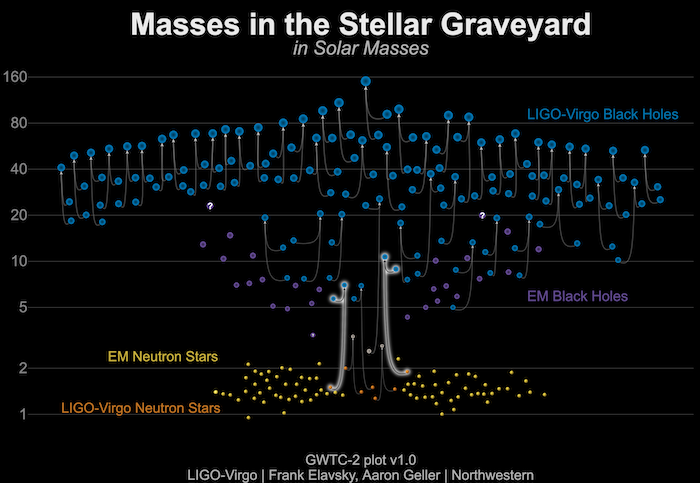Information about gravitational-wave detections of note and catalog releases made by the LIGO-Virgo-KAGRA Collaborations to date. These are listed in reverse chronological order by the announcement date (not the date of detection). After the first few binary black hole detections, detection pages and associated news releases were only made for events of exceptional interest. Catalog entries contain information about multiple detections discovered during a particular observing run. A given catalog release may also analyze events from prior catalog releases. The current full catalog of events can be found on the GWOSC website. An updated list of the most recent public alerts is available on the GraceDB LVK Public Alerts website.
GW230529
April 5, 2024
(Binary consisting of a neutron star + an ambiguous low-mass object.)
O3b Catalog
November 7, 2021
(Release of full catalog from entire third and prior observing runs.)
GW200105 & GW200115
June 29, 2021
(First confirmed observation of neutron star/black hole binaries.)
O3a Catalog
October 28, 2020
(Catalog release for first half of third observing run.)
GW190521
September 2, 2020
(Most massive binary black hole observed up to that date.)
GW190814
June, 23 2020
(Binary consisting of a black hole + an ambiguous low-mass object.)
GW190412
April 18, 2020
(First unambiguously unequal-mass binary black hole detection.)
GW190425
January 6, 2020
(Second binary neutron star & first single-interferometer detection.)
O1/O2 Catalog
December 1, 2018
(All detections from 1st and 2nd observing runs.)
GW170608
November 15, 2017
(The lightest black hole binary observed up to that date.)
GW170817
October 16, 2017
(First observed binary neutron star collision and first EM counterpart.)
GW170814
September 27, 2017
(First signal observed by three interferometers.)
GW170104
June 1, 2017
(Third confirmed binary black hole signal.)
GW151226
June 15, 2016
(Second confirmed observation of gravitational waves.)
GW150914
February 11, 2016
(First direct detection of gravitational waves.)
Detections at a Glance

GW150914 signal observed by the twin LIGO observatories at Livingston, Louisiana, and Hanford, Washington. The signals came from two merging black holes, each about 30 times the mass of our sun, lying 1.3 billion light-years away. The top two plots show data received at Livingston and Hanford, along with the predicted shapes for the waveform. These predicted waveforms show what two merging black holes should look like according to the equations of Albert Einstein’s general theory of relativity, along with the instrument’s ever-present noise. Time is plotted on the X-axis and strain on the Y-axis.

Masses of LIGO/Virgo detections. LIGO and Virgo have observed the merger of several compact object binaries. The black holes represent a new population with masses that are larger than what had been seen previously with X-ray studies alone. This plot shows the masses of the binary components before merger, as well as the mass of the merger remnant. [Image credit: LIGO-Virgo/Northwestern Univ./Frank Elavsky]
Detection Resources
- Full list of LSC Publications. (See Runs O1 and higher for papers following the first detection.)
- Science Summaries
- Gravitational Wave Open Science Center (GWOSC): Download LIGO/Virgo data or explore tutorials on gravitational-wave data analysis.
- Timeline and brief history of the LIGO project.
- The Caltech Media Assets page for GW150914 contains a wealth of useful documents, graphics, and video.
- Image gallery hosted at the LIGO Lab site.
- LSC YouTube Channel, Facebook page, and Twitter page.
- Masses in the Stellar Graveyard: Interactive graphic showing known stellar-mass black holes and neutron stars with mass measurements. (Northwestern/Frank Elavsky/LIGO-Virgo)
- Black Hole Bubble Diagram: Interactive graphic showing known stellar-mass black holes from gravitational-wave candidates and X-ray binaries. (Cardiff University School of Physics and Astronomy/Chris North)
- LIGO Compact Binary Catalogue: Interactive plot showing properties of gravitational-wave detections and candidates. (Cardiff University School of Physics and Astronomy/Chris North)
- Gravitational Wave Viewer: Interactive gravitational waveform viewer, showing the shapes of the gravitational-wave signals detected by LIGO-Virgo (Cardiff University School of Physics and Astronomy/Chris North)
- Sounds of Spacetime: A website that explains the physics of gravitational waves via an analogy between gravitational waves and audio signals. (Montclair State University/Marc Favata)
- LIGO Gravoscope: An interactive tool that lets you compare visions of the Universe in a range of wavelengths. Also shows locations of detected gravitational-wave signals. (Cardiff University Astronomy and Astronomy Instrumentation Groups)
- Gravity Spy: a citizen-science project to help LIGO search for gravitational waves by improving glitch classification.
- Einstein@Home: use your computer’s idle processing time to help search for pulsars using gravitational wave, radio, and gamma-ray data.
- Educator’s Guide: Contains background material on gravitational waves and classroom activities that align with K-12 science standards. (Sonoma State University)

